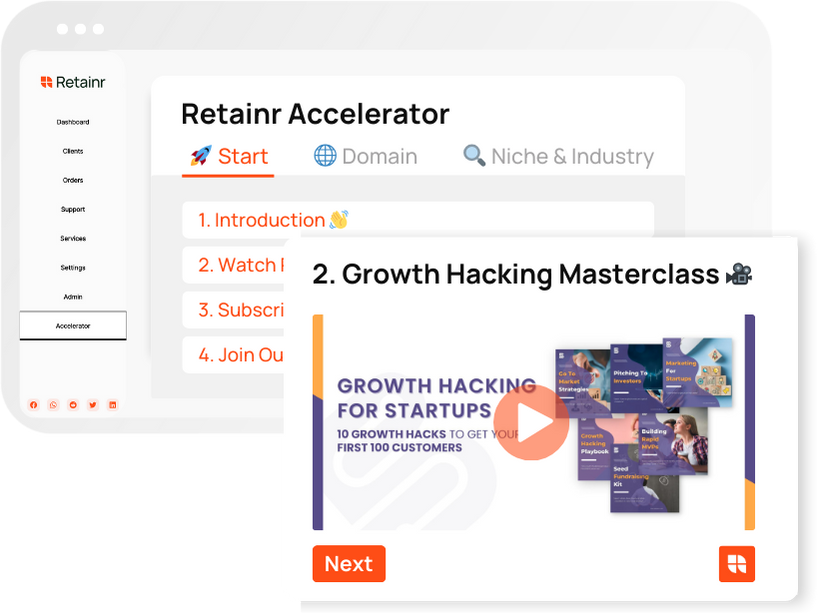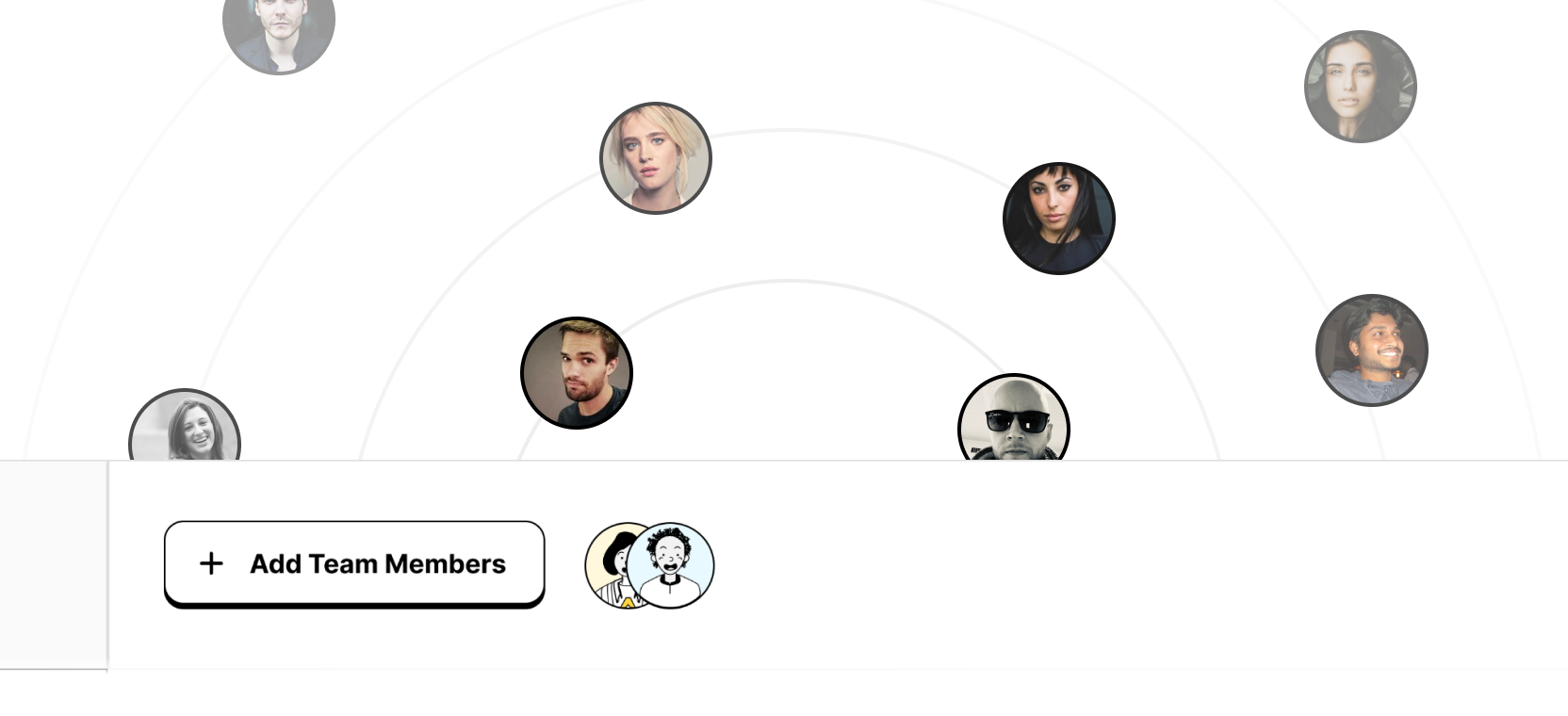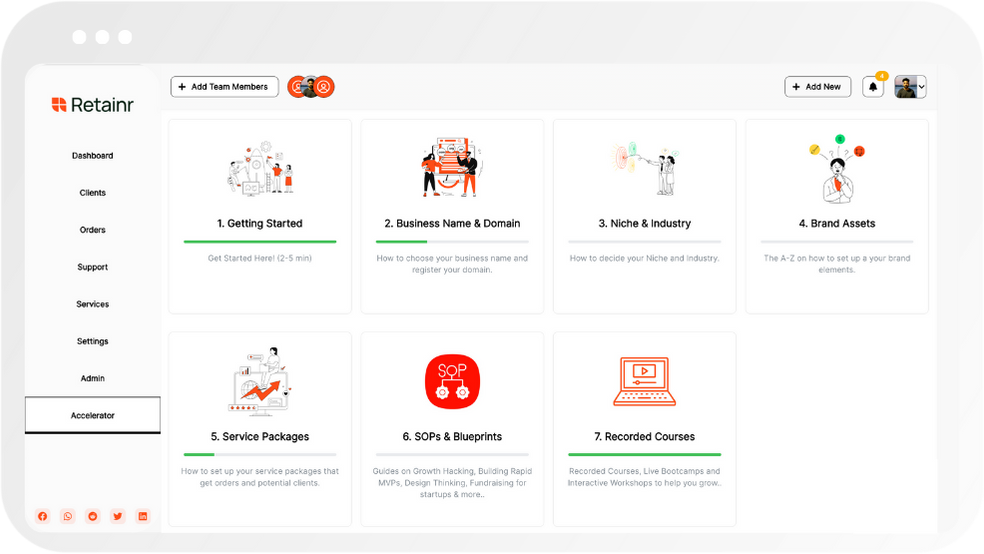
How Do Customizable Agency Workflows Adapt to Changing Needs
Build with Retainr
Sell your products and services, manage clients, orders, payments, automate your client onboarding and management with your own branded web application.
Get Started1. What are customizable agency workflows?
Understanding Customizable Agency Workflows
Customizable agency workflows are adaptable models of business processes or sequence of tasks that agencies use to accomplish particular outcomes. They involve creating, optimizing, and analyzing repeatable patterns of business activities. By being customizable, it enables agencies to tailor their workflows according to their specific organizational needs, demands, and preferences. This implies that these workflows can be adjusted or modified over time to fit evolving business goals, new projects or tasks, changes in staff roles, or emerging technological trends.
Key Features of Customizable Agency Workflows
- Flexibility: They can be redesigned to suit different projects or needs. This makes them particularly useful in managing complex tasks and processes.
- Scalability: Customizable workflows can grow with the organization, adjusting to increased workload or resources. This scalability allows an agency to maintain efficiency as it expands.
- Integration: These workflows can be integrated with other software tools and systems used by the agency. This allows seamless data exchange and harmonized operations.
A Typical Customizable Agency Workflow
| Workflow Stages | Description |
|---|---|
| Initiation | This is the first phase of the workflow where tasks are defined and assigned to the relevant individuals or teams. |
| Execution | On this stage, the assigned team or individual carries out the task, using resources allocated. |
| Monitoring | Progress of the tasks is tracked and managed to ensure efficiency and align with the set deadlines. |
| Completion | This is the final phase where the task is finalized, checked for quality and delivered as expected. |
In conclusion, customizable agency workflows are essential for agencies looking to remain competitive and efficient in the ever-changing business environment. They offer flexibility, scalability, and easy integration with existing systems, all of which help improve productivity and efficiency.
2. How can customizable agency workflows adapt to changing needs?
Customizable Agency Workflows Adaptation
Customizable agency workflows are designed to adapt and evolve with changing needs. This adaptability is achieved through several key methods.
- Scalability: Customizable workflows are built with scalability in mind. As your agency grows, the workflows can be tweaked to handle increased traffic, a broader range of services, or a larger team. This makes them ideal for startups and rapidly expanding agencies.
- Modular Design: Workflows are often designed in modules. As you identify new needs or challenges, you can incorporate additional modules to handle these without disrupting the existing system.
- Data-Driven Adjustments: Most workflows are backed by analytics that track their efficiency. If the data suggests a certain aspect of the workflow isn't achieving its goals, adjustments can be made to improve its performance.
Maximizing Impact with Customizable Workflows
These elements are all intricately linked to maximize the impact of customizable workflows for agencies of all sizes and scopes. They provide the ability to anticipate changes and put measures in place to adapt as swiftly and as efficiently as possible. By keeping an eye on the analytics and continuously refining the process, agencies can stay ahead of the curve and deliver consistently high-quality service.
Comparing Workflow Adaptability
| Workflow Type | Scalability | Modular Design | Data-Driven Adjustments |
|---|---|---|---|
| Customizable | High | Yes | Yes |
| Fixed | Low | No | No |
The comparison clearly showcases the superior adaptability and flexibility of customizable workflows, making them an invaluable tool in a rapidly changing business landscape.
3. What are the benefits of using customizable agency workflows?
Enhanced Efficiency
Using customizable agency workflows comes with numerous benefits, and one of the significant benefits is Enhanced Efficiency. Customizing workflows to suit specific needs often leads to increased efficiency and productivity.
- Reduced redundancy: Custom workflows can help in reducing redundant steps, which in turn, saves significant time for the team.
- Simplified process: Complex procedures can be simplified and made easier to understand and implement.
- Increase in productivity: By automating routine tasks, teams can focus on more essential aspects of their projects, thereby considerably increasing overall productivity.
Boost Team Collaboration
Another significant benefit of customizable workflows is the improvement it brings to team collaboration. By ensuring that all members of a team are on the same page, custom workflows enhance communication and coordination among team members.
| Aspect | Benefit |
|---|---|
| Transparency | Workflows provide a visual overview of the job at hand, ensuring that everyone knows their role and responsibilities. |
| Accountability | Clearly defining who is responsible for what task prevents misunderstandings and promotes accountability. |
| Coordination | By aligning all tasks methodically, a fluid movement of information is established which enhances the overall coordination. |
Adapting to Changes
The ability to adapt to changes quickly and effectively is another significant advantage of using custom agency workflows. By enabling fast adaptation to changes, custom workflows allow businesses to stay competitive and relevant in today's fast-paced world.
- Scalability: As businesses grow and evolve, custom workflows can be easily scaled to accommodate new tasks or changes.
- Flexibility: Custom workflows are flexible, making it easy to adapt to unexpected changes or situations.
- Improved customer satisfaction: Fast adaptation to changes allows businesses to meet their customer's needs more effectively, thereby improving customer satisfaction.
4. What types of changes can customizable agency workflows adapt to?
Changes in Business Requirements
Customizable agency workflows can adapt to changes in business requirements, which may be influenced by diverse factors such as evolving customer needs, regulatory changes, or new business strategies. Through customization, workflows can be modified to address new tasks, improved processes, or completely new services or products.
- New tasks: These are tasks made necessary by new business requirements. For example, if a digital marketing agency starts offering SEO services, workflows will need to be adjusted to include activities such as keyword research and on-page optimization.
- Improved processes: Regular evaluations may reveal that certain processes can be improved. Changes in workflows can implement these improvements.
- New services or products: When an agency introduces new services or products, workflows must be updated to accommodate the tasks needed to deliver those offerings.
Changes in Staffing or Resources
The capacity of an agency can fluctuate due to changes in staffing or resources affecting how tasks are distributed and completed. Customizable workflow tools provide the flexibility to adapt to these changes to ensure the seamless operation of the agency. This includes alterations in roles, shifting team structures, or variations in available resources.
| Changes | How workflows can adapt |
|---|---|
| Alterations in roles | Workflows can accommodate new roles or changing job responsibilities by assigning appropriate tasks to the right individuals. |
| Shifting team structures | In case of team restructures, workflows can be adjusted to reflect new reporting lines or task distributions. |
| Variations in available resources | Workflows may be flexible to absorb changes in resource availability by redistributing tasks or altering timeframes. |
Changes due to Technological Advancements
With the rapid pace of technological progress, agency workflows need to constantly adapt to leverage new tools or to maintain compatibility with updated systems. Customizable workflows can accommodate these changes, whether it's integrating new software, automating tasks for efficiency, or adjusting to improvements in existing tools.
- Integration of new software: Workflows can be customized to incorporate steps involving the use of new software or digital tools.
- Automation of tasks: With the advent of newer technologies, certain tasks can be automated. Customizable workflows can be designed to make the best use of such automation.
- Adjustment to upgrades: Existing software may be upgraded or transformed. Workflow customization allows such changes to be incorporated into daily task management.
5. How quickly can the customizable agency workflows adapt to changing needs?
Speed of Adaptation
The speed at which customizable agency workflows can adapt to changing needs largely depends on the specific system in place and the nature of the changes. However, with most modern systems, changes can often be implemented almost immediately. This is primarily due to the inherent design of these workflows, which are built on flexibility and adaptability.
- Immediate Changes: Simple alterations, like modifying the order of a workflow or reassigning tasks, can typically be done in real time. These changes will propagate through the system immediately, meaning users can notice the updates in their workflow without delay.
- Short-term Changes: More substantial changes, such as adding new components or functionality to the workflow, may require a bit more time. However, these adjustments are usually completed within hours or a few days at most.
- Long-term Changes: Major overhauls, like integrating with a new system or fundamentally changing the structure of the workflow, will obviously take more time. Nevertheless, even these significant changes could be implemented within a few weeks or months, thanks to the customizable nature of the workflows.
Benefits of Fast Adaption
With such quick adaptation capabilities, customizable agency workflows provide several benefits for businesses in dynamic industries. Being able to quickly adapt to changing needs allows companies to maintain efficiency and productivity in their operations, even in the face of unforeseen circumstances or sudden shifts in their industry.
| Benefit | Description |
|---|---|
| Efficiency | Quick adaptation minimizes downtime, ensuring workflows continue to run smoothly without interruption. |
| Productivity | By quickly adjusting to changes, teams can keep working without stalling or waiting for long periods of system updates. |
| Competitiveness | Businesses that adapt faster to changes can capitalize on new opportunities quicker than their competition. |
| Customer Satisfaction | Adapting swiftly to changing needs means being able to meet customer expectations more reliably and promptly. |
6. Can customizable agency workflows be adjusted for different sized organizations?
Customizable Agency Workflows Adaptation for Different Sized Organizations
Customizable agency workflows represent a paradigm shift in how organizations of different sizes manage their operations. Indeed, the flexibility of these systems allows for adjustments tailored to the specific needs and dynamic changes present in various organizations. This compatibility can be seen in small-scale businesses, mid-sized companies and large corporations.
Parameters of Workflow Adjustments
The critical parameters used to adjust workflows in different sized organizations include process complexity, team size, and resource allocation. In small businesses, the processes are less complex, the team size is often small, and the resources are limited. Therefore, the workflow systems for such organizations are designed to be simple, direct, and very efficient.
- Process Complexity: Simple processes for small businesses, moderate for mid-sized organizations, and complex for large corporations.
- Team Size: Small team sizes for small businesses, moderate for mid-sized enterprises, and large for big organizations.
- Resource allocation: Limited resources for small businesses, moderate for mid-sized companies, and abundant for large corporations.
Demonstration through a Comparative Table
| Organizational Size | Process Complexity | Team Size | Resource Allocation |
|---|---|---|---|
| Small | Simple | Small | Limited |
| Mid-sized | Moderate | Moderate | Moderate |
| Large | Complex | Large | Abundant |
The above comparative table clearly illustrates how customizable agency workflows can be tailored to meet the varying needs of different sized organizations. This adaptability not only enhances operational efficiency but also promotes scalability and growth within the business environment.
7. Are there any specific examples of how a customizable agency workflow has adapted to a business's changing needs?
1. E-commerce Company Adapting to Industry Changes
An e-commerce company previously relied on a linear workflow that no longer met its goals due to changes in the market dynamics and customer behavior. With a new customizable agency workflow, the company could implement a more seamless and flexible project management system. This system allowed them to:
- Conduct regular testing and make changes based on real-time data.
- Efficiently track customer behavior through advanced analytics.
- Improve product development and marketing strategies
This transformation allowed the company to thrive in a rapidly changing e-commerce landscape.
2. Digital Marketing Agency Streamlining its Operations
A digital marketing agency previously relied on several different tools and applications for its day-to-day operations. They adopted a customizable workflow software that consolidated all their needs into a single platform. The table below outlines the transition:
| Before | After |
|---|---|
| Various disjointed apps for project management | A unified platform integrating all project management needs |
| Unstructured data causing inefficiencies | Well-organized data for quick and easy access |
| Poor team collaboration due to lack of centralized platform | Improved team collaboration due to a centralized communication hub |
3. Software Development Company Moving to Agile Processes
In the past, a software development company employed waterfall customizable agency workflows, where projects would be completed in a strict sequence. However, as the company grew and its client needs more complex, it needed to shift to agile methodologies to better accommodate the fluid nature of software development. The new workflow solution allowed the company to:
- Adopt a flexible and iterative approach to project execution.
- Incorporate feedback more readily into the development process.
- Greatly improve delivery times and client satisfaction.
This transformative experience underlined the importance of customizable workflows in adjusting to fluctuating business needs.
8. What are the steps to customize agency workflows to adapt to changing business needs?
Identifying Work Process Improvements
Customizing agency workflows involves identifying the requirements for change and then implementing those changes. First, the organization must pursue a thorough analysis of the current workflow to understand how and where improvements can be achieved. To help with this, a list of key steps includes:
- Identify which parts of the workflow are inefficient or outdated
- Analyze if there are unnecessary steps that can be removed
- Determine the areas where automation can bring efficiency
Developing a Customized Workflow Plan
Once the areas of potential improvement have been identified, the next step is to develop a customized workflow plan. It's essential to include every team member involved in the process to ensure that the plan meets everyone's needs. The plan might evolve in terms of:
| Task | Responsibility | Timeline |
|---|---|---|
| Identify workflow goals | Team leader | Week 1 |
| Define new process steps | Process owner | Week 2 |
| Test and refine the new workflow | Entire team | Week 3-4 |
Implementing and Reviewing the New Workflow
The final stage of customizing agency workflows involves implementing the new workflow and then reviewing its effectiveness after some time. This reinforcement process often includes these steps:
- Train team members in the new processes
- Implement the new processes
- Regularly review the effectiveness of the new workflow
- Adjust the workflow as necessary, based on feedback
Thus, through customization, the workflow can be made to adapt to the ever-changing needs of the business.
9. What sort of skills or tools are needed to customize agency workflows?
Skills Required to Customize Agency Workflows
Managing and customizing agency workflows effectively necessitates the acquisition of specific skills and tools. To start, one must have a solid understanding of workflow analysis. Being able to examine the current operational process and envisage a more productive sequence is key. Additionally, project management skills are indispensable as agency workflows involve many procedures and individuals. Strong communication skills is another crucial, yet often overlooked component. Clear and concise communication mitigates misunderstandings and ensures all team members are on the same page. Lastly, a grasp of various process visualization tools is beneficial.
- Workflow analysis
- Project management skills
- Communication skills
- Process visualization tools
Tools Needed to Customize Agency Workflows
In terms of the tools required, software or applications which allow for the creation and modification of workflows are indispensable. Many of these are cloud-based which allow for real-time updating and collaboration. Platforms like Monday.com, Trello, and Asana are prime examples of these. Also, a quality Customer Relationship Management (CRM) system might be essential depending upon the agency's client base and needs. Lastly, investing in a solid project management software that includes time tracking and budgeting features can streamline workflow customization.
| Tools | Description |
|---|---|
| Workflow software | Allows for the creation and modification of workflows. Examples include Monday.com, Trello, and Asana. |
| CRM System | Manages an agency's interactions with current and potential clients. |
| Project Management Software | Incorporates time tracking, budgeting, and other features to streamline workflow customization. |
10. Are there any downsides or challenges to customizing agency workflows?
Challenges of Customizing Agency Workflows
Customizing agency workflows, despite its myriad benefits, isn't free from challenges. There are significant hurdles organizations may face when launching a customization exercise. These challenges slow down processes, increase costs and might even offset the expected benefits from customization, if not well managed. Let's explore these challenges:
- Limited In-house Skills: In many organizations, there's often a lack of the necessary expertise to manage customization. This gap leads to erroneous configurations, creating inefficient workflows.
- Time and Cost: Customizing agency workflows often means investing in new software or modifying existing ones. This undertaking is not only expensive but also time-consuming.
- Integration Issues: Custom workflows may fail to seamlessly integrate with your existing systems, causing disruptions and errors in the different components of the agency's operations.
- Resistance to Change: Employees might find it difficult to adapt to new workflows. It leads to resistance, reducing the effectiveness of the new system.
Addressing Potential Downsides
Overcoming these hurdles requires deliberate strategies to make customization a successful endeavor. Here is a summary of steps an organization can take to mitigate potential downsides of customizing agency workflows:
| Challenge | Solution |
|---|---|
| Limited In-house Skills | Invest in training and development for your team before and during the process of customization. |
| Time and Cost | Plan, budget, and implement in phases to evenly spread the cost and time needed for customization. |
| Integration Issues | Ensure the customized workflows are compatible with your existing systems or seek third-party integration solutions. |
| Resistance to Change | Encourage employee buy-in by involving them in the customization process and providing adequate training on the new system. |
Conclusion
Customizable Agency Workflows: Adaptability to Changing Needs
In the dynamic business environment, success is contingent on an agency's ability to adapt to changing needs swiftly. A customizable agency workflow is a game-changer, offering the flexibility to evolve processes, streamline operations, and boost efficiency dynamically.
These workflows allow for quick adjustments geared towards meeting emerging trends, client demands, or changes in the agency's internal operations. By allowing for real-time modifications, customizable workflows enhance responsiveness, improving client satisfaction and overall operational productivity.
Retainr.io: A Tool for Efficient Workflow Customization
Retainr.io is a leading whitelabel software solution designed to enhance customization of agency workflows for better adaptability. With this solution, agencies can seamlessly sell, manage clients, orders, and payments through their own branded app, therefore boosting their competitiveness and market visibility.
Retainr.io allows for flexibility and control in workflow design and management for optimal efficiency and productivity. The software supports a customizable approach to internal processes and client management, ensuring that agency workflows stay up to date with industry trends and client demands.
Embrace Workflow Adaptability with Retainr.io
The rapidly changing business landscape calls for an agile and scalable tool like Retainr.io. By embracing this software, agencies can adjust to the ever-evolving needs, stay competitive, retain clients, and foster their growth. Try Retainr.io now and experience the power of adaptive, customizable agency workflows.
Boost Your Agency Growth
with Retainr Accelerator
Uncover secrets, strategies, and exclusive blueprints to take your agency's growth to the next level — from marketing insights to effective presentations and leveraging technology.

SOPs, Cheatsheets & Blueprints
Leverage 50+ SOPs (valued over $10K) offering practical guides, scripts, tools, hacks, templates, and cheat sheets to fast-track your startup's growth.
Connect with fellow entrepreneurs, share experiences, and get expert insights within our exclusive Facebook community.
.jpg)

Join a thriving community of growth hackers. Network, collaborate, and learn from like-minded entrepreneurs on a lifelong journey to success.

Gain expertise with recorded Courses, Live Bootcamps and interactive Workshops on topics like growth hacking, copywriting, no-code funnel building, performance marketing and more, taught by seasoned coaches & industry experts.

.jpg)

.jpeg)


